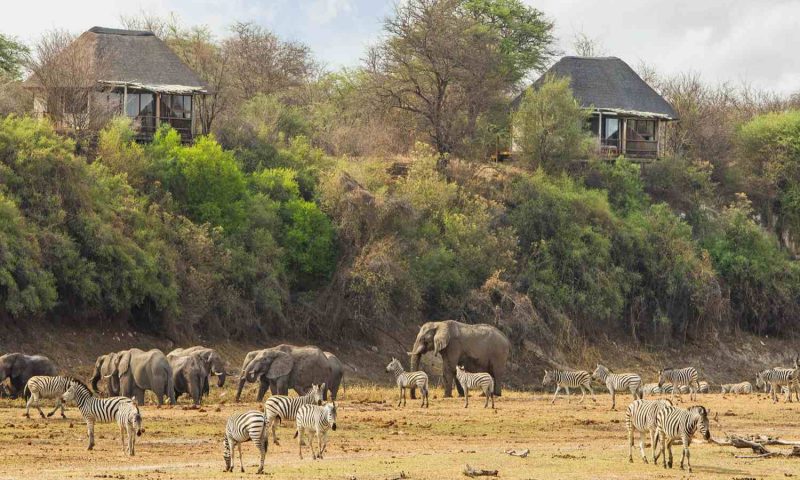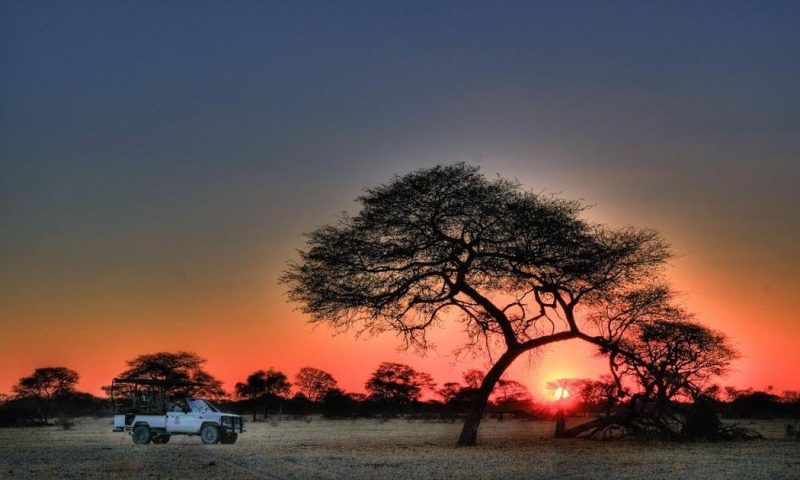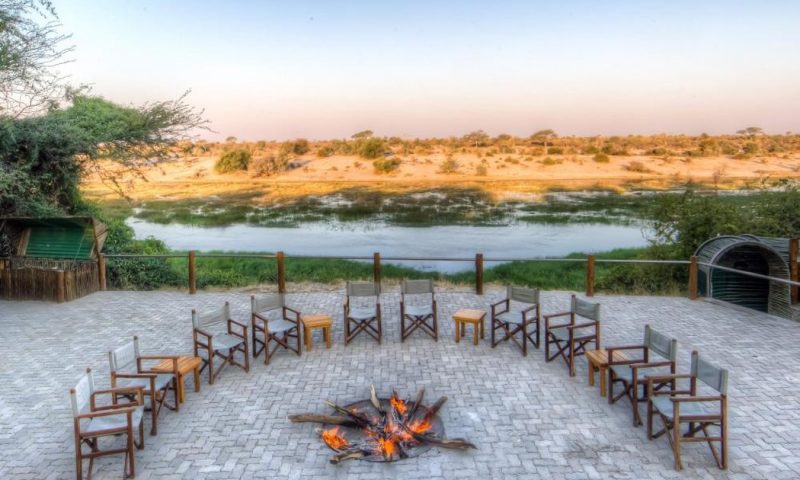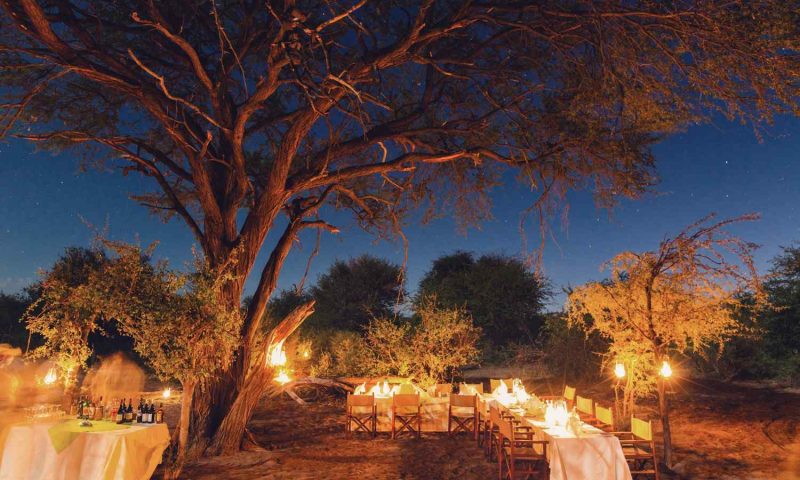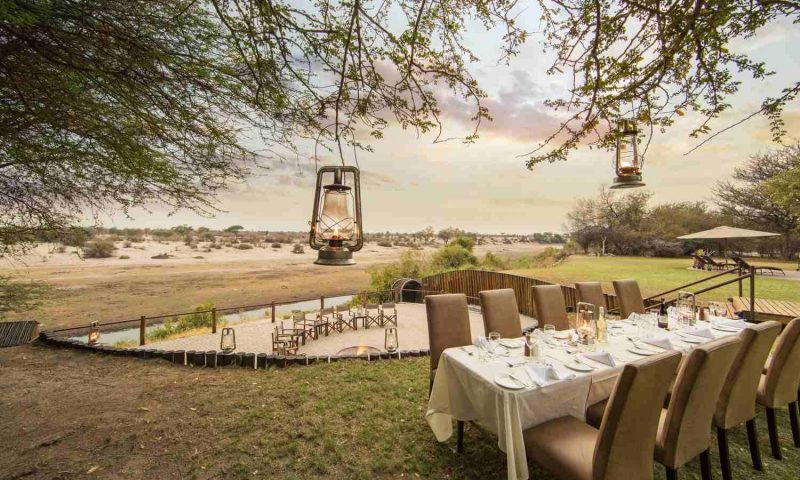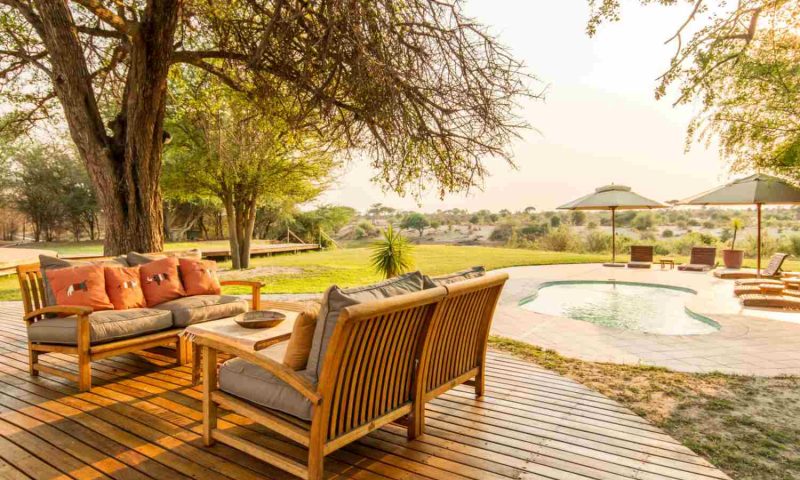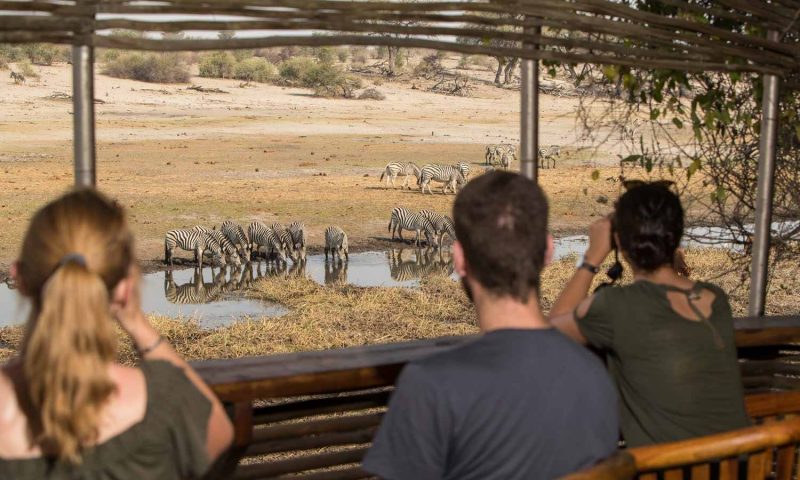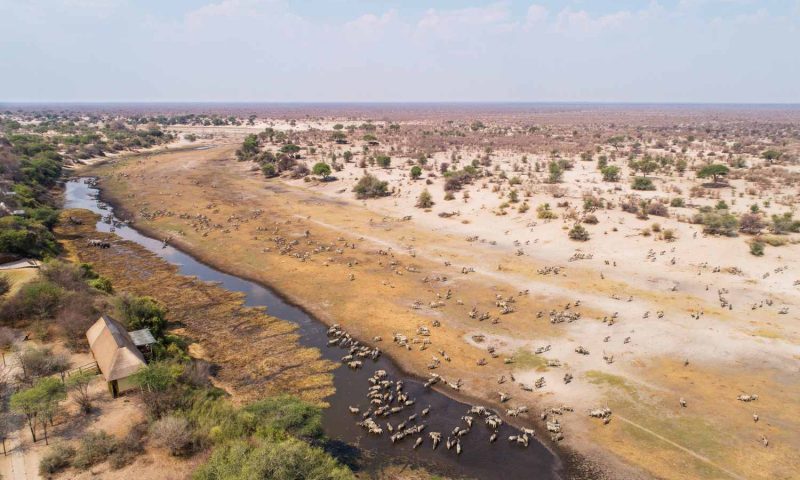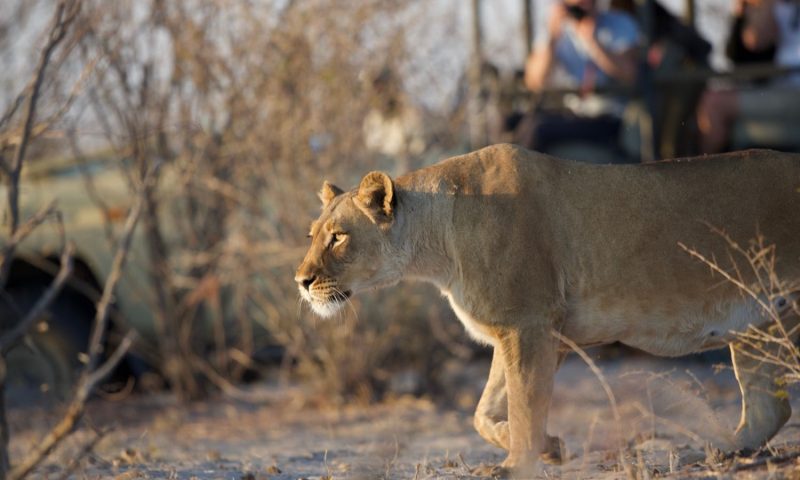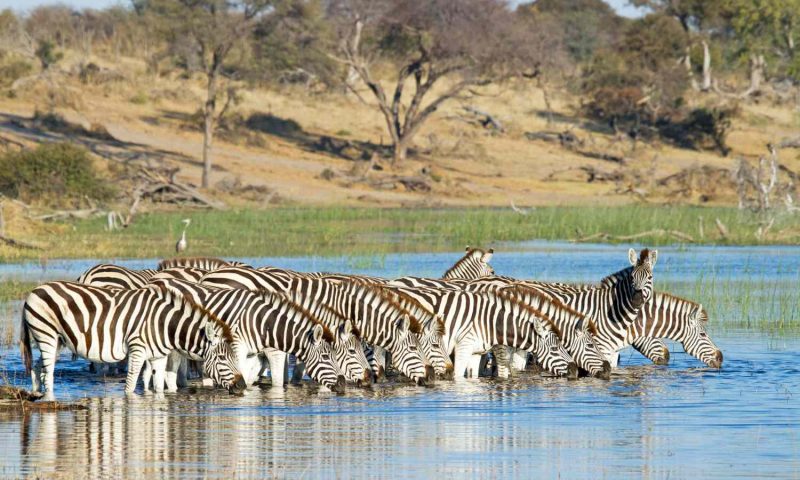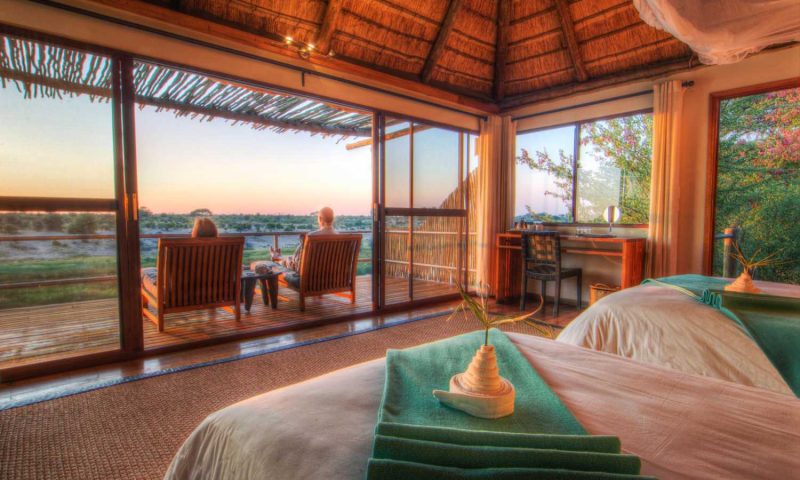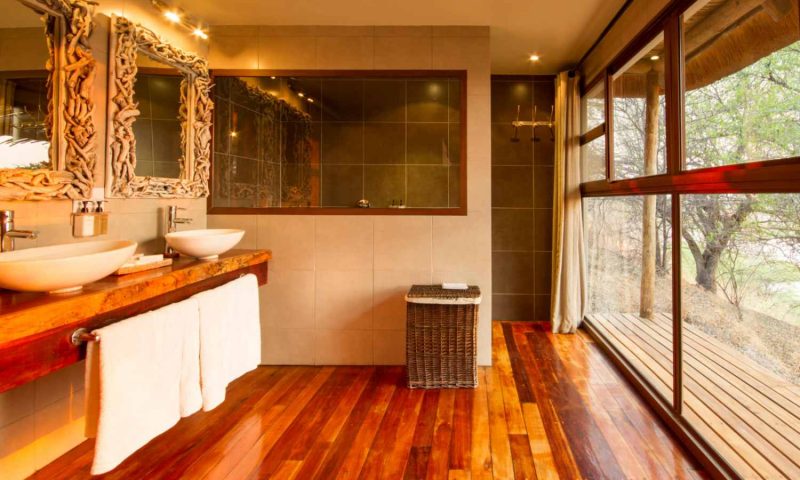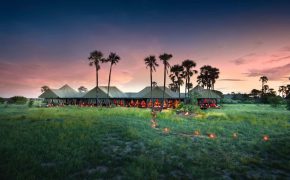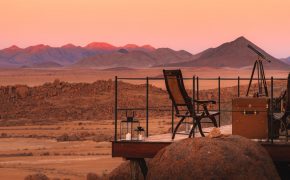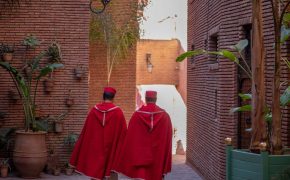Leroo La Tau is situated on the western bank of the Boteti River, which forms the boundary of the Makgadikgadi Pans National Park.
The Boteti River provides a lifeline for the wildlife which inhabit the arid national park and is a critical link in the annual zebra migration. Leroo La Tau is the perfect base from which to explore this truly unique piece of Botswana paradise.
A UNIQUE HISTORY
The Boteti River is the main outflow of the Okavango Delta, collecting the water that flows past Maun and stretching about 250 kilometres southeast to Lake Xau on the extreme south-western edge of the great Makgadikgadi salt pans.
In the mid-1980s the flood waters of the Okavango Delta started to decline as the region entered a cycle of low rainfall, and consequently the Boteti River began to recede. The river stopped short of Leroo La Tau in 1988, and by the mid-1990s had dried up completely.
Leroo La Tau was left with a few waterholes in the riverbed which continued to offer refuge to a small pod of landlocked Hippo, together with Crocodiles which became completely terrestrial, making dens in riverbank ‘caves’ downriver from the lodge.
Large numbers of Zebra and Wildebeest continued to graze the rich grass plains, migrating to the Boteti River at the end of winter to access the remaining waterholes.
In 2009, two decades after the Boteti River stopped flowing, record rainfall resulted in the highest Okavango flood levels for 25 years, and the river once again flows past Leroo La Tau.
Leroo La Tau is built on cliffs over 10 metres above this changing riparian environment, offering a vantage point that ensures unsurpassed views of the river and the Makgadikgadi Pans to the east.
THE LODGE & ACCOMMODATION
The lodge features twelve luxurious thatched and glass-fronted suites with en-suite bathrooms, each unit raised on a wooden platform overlooking the Boteti River Valley below.
With the lodges unique location poised on the edge of the Boteti River enjoying the zebra migration and abundant wildlife that access the river is possible from various vantage points including the guest rooms.
The main lounge and dining area, with its inviting wooden and thatch finish, allows you to relax at the bar while listening to the wide variety of night sounds so characteristic of the African bush.
Alternatively you can lounge around the swimming pool or enjoy the panoramic river vista from the game-viewing hide built into the bank of the river.
ACTIVITIES & WILDLIFE SIGHTINGS
The lodge offers guided game drives in the Makgadikgadi Pans National Park focusing on the exceptional wildlife sightings along the Boteti River. Depending on the water level, boat activities are also provided.
Optional cultural excursions can be arranged to Khumaga Village as well as day trips to Nxai pan and Baines Baobabs (three-night stay only). For those looking for a truly unique experience, enjoy a sleep out under the stars on the Makgadikgadi Salt Pans (three-night stay).
Leroo La Tau translates as ‘lion’s paw’ but, although the surrounding area features abundant Lion, Zebra and Wildebeest, it also boasts Chobe Bushbuck, Leopard, Cheetah, Brown and Spotted Hyena, Impala, Kudu, Jackal, Porcupine, Genet and Caracal, to name but a few.
Please note: Owing to their remote location within the Makgadikgadi Pans National Park, the Makgadikgadi Pans themselves are not visited on daily scheduled activities from Leroo La Tau.
WINTER (APRIL TO SEPTEMBER)
The days are dry, sunny, clear and cool to seductively warm, while in the evening temperatures drop sharply. Daytime temperatures generally reach 25 °C, and may fall as low as 2 °C (and plummet below freezing in some areas) at night. Virtually no rain falls during the winter months.
SUMMER (OCTOBER TO MARCH)
The summer or rainy season begins in October and ends in March. In October the weeks preceding the coming of the rains tend to be the hottest, with temperatures soaring up to 40 °C or more.
Cloud cover and the arrival of the first rains towards the end of November or in early December cool things down considerably, although usually only for a short period.
BIRD ENTHUSIASTS
The arrival of summer sees the influx of a large variety of migrant birds from the northern hemisphere which use Botswana – and more specifically the Okavango Delta – as preferred areas for breeding and feeding.
The first migrants arrive during September. They will all have arrived by December, which increases Botswana’s bird population by 20% compared to the winter months. The period from December to March is very active and the colours, especially with the birds in breeding plumage displaying, are spectacular.
The Okavango Delta is a birders’ paradise, which entertains both the experienced ornithologist and the eager amateur. One of the highlights of the birding calendar takes place during September–October, when the Carmine Bee-eaters arrive from Central Africa and are often seen in their hundreds on the Savuti Marsh.
Interestingly, they make use of the large Kori Bustards, by riding on their backs as they move through the grass of the marsh and kick up fleeing insects, which are then caught by the bee-eaters.
Another highlight is the heronry at Gadikwe Lagoon, which provides nesting sites for hundreds of birds. (The Gadikwe Lagoon is situated between Camp Moremi and Camp Okavango and/or Xugana Island Lodge, and is a highlight for guests taking the boat transfer between the lodges.)
Owing to the heronry being shared by a variety of species it is active from July to March and is busiest from September to December, when breeding colonies of herons are joined in the shallows and among the low trees and swamp-fig thickets by Marabou, Yellow-billed and Saddle-billed Storks, Sacred Ibis and several species of egret.
Flapping, noisy and colourful breeding displays can be enjoyed at close quarters (although we maintain a 50 metre exclusion zone).
LANDSCAPE & WILDLIFE
After the first rains, the landscape in Botswana transforms into a subtle green blanket. Grasses shoot and leaves appear on what seem to be dead plants and it is a wonderful time of the year to experience the magnificent springing of life in Botswana.
The vegetation is lush and green and most of the plants are in bloom. February is peak flowering time for water lilies and the landscape is decorated with wild flowers.
Savuti, in particular, and the area between the river and the wooded dunes in Chobe, break out in bright yellows, whites and purples among the green blanket that covers the ground. The sweet smell of fresh grass and Wild Sage at Savuti fills the air and adds to the powerful effect on the other senses.
When the summer rains begin towards the end of November the barren-looking earth of Savute comes alive. Its rich new grasses are a magnet for herds of Burchell’s Zebra and Wildebeest, which can be found on the Savute marsh where they foal before making for the lush grazing grounds of the Mababe Depression further south, on the edge of the Makgadikgadi Pans.
Large herds of Buffalo gather from the Okavango and move through toward the mainland of Moremi, where there are now sufficient pools of water to sustain them.
As the rains cease towards the end of February and the pans evaporate as the dry season looms the herds gather once again. Closely followed by predators, they make their annual journey from Savute to the Linyanti to arrive around April.
During the winter months the banks of the Chobe River and the Xakanaxa area of Moremi become the livelihood of the wildlife, as there is no surface water in the surrounding bush.
Elephant and buffalo are also migratory, making seasonal movements of up to 200 km from the Chobe River, where they concentrate in the dry season, to the pans in the Mopane woodlands in the south near Savuti, where the grass is very nutritious.
November to March are great months, as the air clarity is unparalleled, trees begin to burst into life, the new grass is green and lush, skies are dramatic as big clusters of clouds precede the rains and animals are giving birth. It’s a wonderful time for the photographer, as there is plenty of action, colour and visibility.
April to October bring cooler morning air along with warmer water, which can lead to wonderful early-morning misty magic, especially over the Okavango. The Buffalo begin to gather into large herds and visit the rivers more often as the seasonal pans begin to dry up.
Along the Chobe River, breeding herds of Elephant increase in density daily as they visit those rivers and pans containing permanent water. African Wild Dogs den in June and it is possible to witness exciting hunts in the Savuti and Moremi areas.
Herbivores begin to concentrate at the permanent water sources, as do their predators. Soft early-morning and evening light combined with dust provides many dramatic photo opportunities. In July the bush is bare and the dust pervasive, but there is plenty of action and with patience and perseverance the rewards are great.
At first small family groups of Zebra move closer to the Boteti River, but they are soon there in their thousands as winter turns into spring and the first rains fall. These are generally followed by exciting predator activity and spectacular raptor sightings in the Leroo La Tau area.
TEN NIGHTS / ELEVEN DAYS – KASANE TO MAUN
The 10-night Desert & Delta Safaris Honeymoon package is the perfect Botswana itinerary for honeymooners, couples sharing a special celebration or guests looking for the ultimate romantic safari through Botswana’s best safari regions.
Designed for the romantics at heart, the ten night package includes a host of unique couple focused experiences to remember.
CHOBE GAME LODGE, CHOBE RIVER FRONT (3 NIGHTS)
On arrival at the Kasane Airport you will be warmly welcomed by one of the Chobe Game Lodge guides and transferred by open game drive vehicle to Chobe Game Lodge.
Spend three nights at Chobe Game Lodge in our luxurious honeymoon suite complete with private patio and plunge pool facing the Chobe River. With daily game drives and exciting river safaris on offer, Chobe Game Lodge is the perfect start to your Botswana adventure.
The lodge offers a variety of luxuries allowing you to take the necessary time to relax and enjoy the beautiful surroundings. The honeymoon package includes a sunrise breakfast cruise on the Chobe River for a chance to take in the tranquillity of the Chobe River in the early morning.
CAMP MOREMI, MOREMI GAME RESERVE (3 NIGHTS)
After your final morning activity at Chobe Game Lodge, you head back to Kasane Airport for your light aircraft transfer to Camp Moremi in the Moremi Game Reserve.
Your light aircraft flight will offer you an introduction to the Okavango Delta as you witness the vastness of the world heritage site from the air. Landing at the Moremi airstrip, your guide will meet you and transfer you by road to Camp Moremi where you can settle into your luxurious tent.
You will spend the next three nights at Camp Moremi enjoying game drives and boating excursions as you search for the prolific wildlife that inhabits the Moremi Game Reserve.
Your honeymoon package includes a private dinner setup in a remote location of the lodge where you can take in the lodge’s romantic bushveld setting.
THE OKAVANGO DELTA WITH CAMP OKAVANGO (2 NIGHTS)
Enjoy a final morning game drive in the Moremi Game Reserve before your light aircraft transfer to Camp Okavango, a remote lodge on a private concession in the heart of the Okavango Delta. Originally built in 1982, Camp Okavango is one of the original safari camps on the Okavango Delta.
Now rebuilt as an all new luxury safari lodge, Camp Okavango is the perfect base from which to experience the Okavango Delta. Here you will spend the next two nights exploring the intricacies of the Okavango Delta from a variety of activities including mokoro excursions, boating safaris and guided bush walks.
Your honeymoon package includes a 60-minute helicopter scenic flight including a private romantic champagne sundowner on a remote island in the Okavango Delta.
THE BOTETI RIVER WITH LEROO LA TAU (2 NIGHTS)
Your final stop for of your honeymoon package is Leroo La Tau. You will catch a light aircraft from Camp Okavango to Leroo La Tau before transferring by road the lodge, set on the banks of the Boteti River, overlooking the Makgadikgadi Pans National Park.
You will spend the next two nights at Leroo La Tau enjoying daily game drives along the Boteti River to witness the prolific wildlife that frequent the region. Option excursions to the nearby Khumaga village are also available for a chance to experience Botswana’s unique culture.
As a final farewell gift, you will enjoy a traditional Setswana blessing with the staff at Leroo La Tau and members of the khumaga community. After your two-night stay at Leroo la Tau you will be transferred by light aircraft to Maun for your onward journey.
